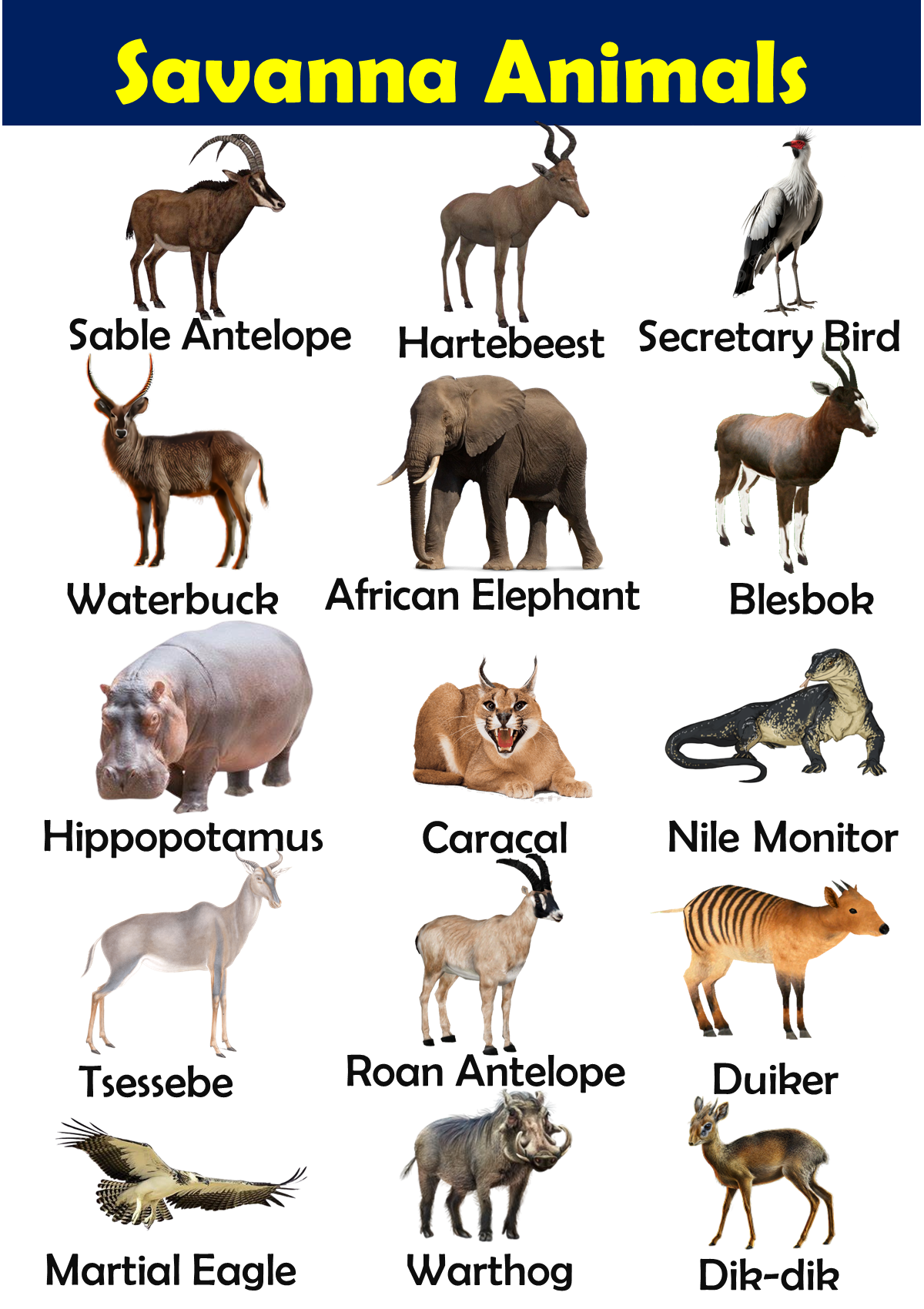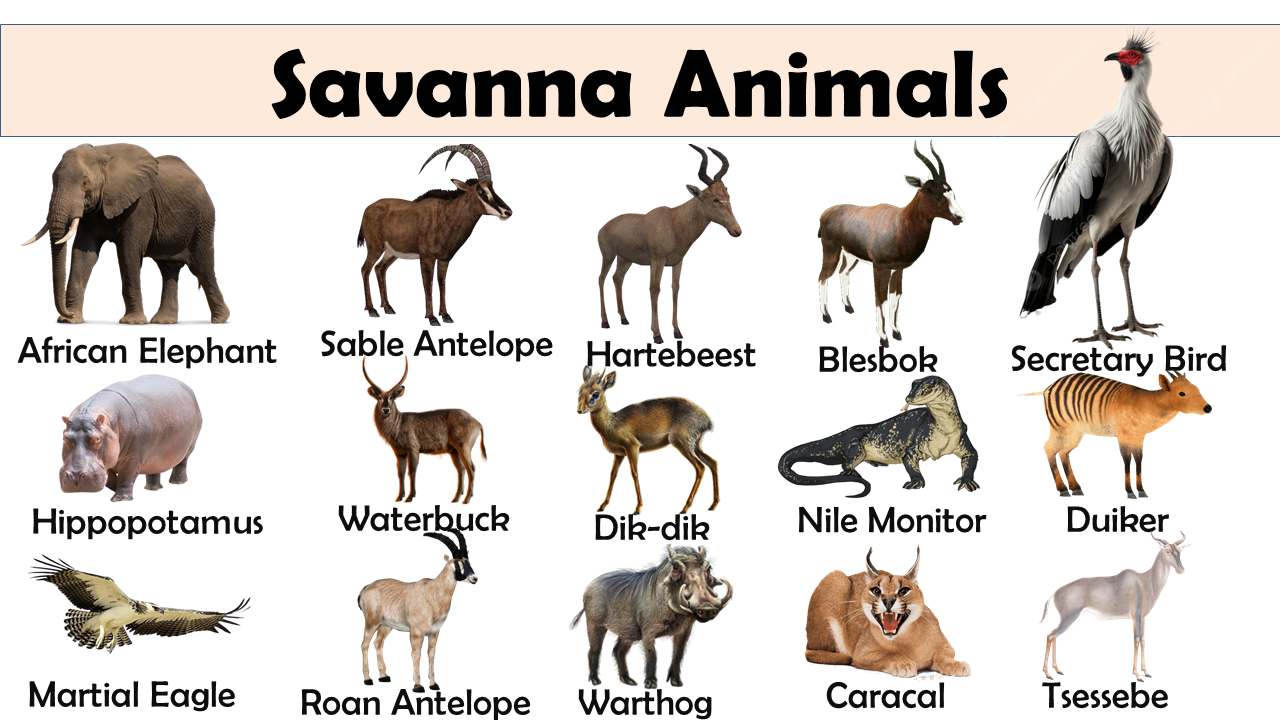The savanna is a fascinating place, full of wide open spaces and amazing animals. It’s like a big, natural home where creatures such as lions, elephants, and zebras live. In this post, we’ll explore some of the unique animals that call the savanna their home. You’ll learn new words and fun facts about each one. Let’s discover the wild and wonderful world of savanna animals together!
What are Savanna Animals?
The savanna is a mixed ecosystem that combines grasslands with scattered trees and is found across several continents including Africa, South America, and Australia. This biome is characterized by its seasonal rainfall patterns, with a distinct dry season and a wet season. Animals in the savanna are adapted to this environment with many developing migratory patterns to follow the rains and food supply.
List of Savanna Animals
- African Elephant
- Lion
- Cheetah
- Giraffe
- Zebra
- Wildebeest
- Hyena
- African Wild Dog
- Warthog
- Gazelle
- Impala
- Ostrich
- Hippopotamus
- Rhinoceros
- Meerkat
- Kudu
- Springbok
- Vulture
- Secretary Bird
- Thomson’s Gazelle
- Cape Buffalo
- Sable Antelope
- African Grey Hornbill
- Jackal
- Marabou Stork
- Caracal
- Eland
- Bushbaby
- Baboon
- Hartebeest
- Crocodile
- Tsessebe
- Blesbok
- Lappet-faced Vulture
- Waterbuck
- Topi
- Red Hartebeest
- Seriema (South American savanna)
- Maned Wolf (South American savanna)
- Giant Anteater (South American savanna)
- Macaw (South American savanna)
- Jabiru (South American savanna)
- Capybara (South American savanna)
- Rhea (South American savanna)
- Collared Peccary (South American savanna)
- Bushveld Gerbil
- Brown Hyena
- Blue Wildebeest
- African Hawk-Eagle
- Cheetah Cub
- Dik-dik
- Grant’s Gazelle
- Roan Antelope
- Gnu
- African Buffalo
- Spotted Hyena
- Black-backed Jackal
- Bat-eared Fox
- Nile Monitor
- Honey Badger
- Pangolin
- Duiker
- African Fish Eagle
- Martial Eagle
- Serval
- Leopard Tortoise
- Greater Kudu
- Banded Mongoose
- African Harrier-Hawk
- Painted Wolf
Explore More Animal Vocab:
Madagascar Animals | Tundra Animals | Taiga Animals

Savanna Animals Vocabulary and Their Facts
1. African Elephant
The African elephant is the largest land animal, characterized by its large ears that help dissipate heat. These intelligent mammals have complex social structures and communicate through vibrations. Elephants play a crucial role in their ecosystem by facilitating seed dispersal and modifying landscapes, which helps maintain the savanna’s biodiversity.
2. Lion
Known as the “king of the jungle,” lions actually inhabit the savannas and grasslands. They are the only big cats that live in groups, called prides, which are typically led by females. Lions are apex predators, with their diet consisting primarily of large ungulates.
3. Cheetah
The cheetah is renowned for being the fastest land animal, capable of speeds up to 120 km/h in short bursts covering distances up to 500 meters. This adaptation allows them to catch fleet-footed prey such as gazelles. Cheetahs have non-retractable claws that provide better traction during their high-speed chases.
4. Giraffe
Giraffes are the tallest mammals on Earth, with their long necks and legs helping them to reach leaves high in trees, beyond the reach of other herbivores. They also have a prehensile tongue approximately 45 cm long, which helps them pull leaves from branches.
5. Zebra
Zebras are known for their distinctive black and white stripes, which are believed to serve as camouflage and to confuse predators. They are highly social animals and often seen in large herds that mingle with other grazers, providing safety in numbers.
6. Wildebeest
Wildebeest are famous for their annual migration across the African savanna, a spectacular sight involving millions of animals, which is crucial for their survival as it allows them to follow seasonal rainfall and grass growth.
7. Hyena
Often misunderstood as mere scavengers, hyenas are efficient predators with a bite force capable of crushing bones. They are known for their complex social structures and are more closely related to cats than to dogs.
8. African Wild Dog
Also known as painted wolves, African wild dogs are known for their distinctive coats and highly social behavior. They are formidable hunters that hunt in packs, known for their high success rate in comparison to other large predators.
9. Warthog
Warthogs are sturdy animals, easily recognizable by their curved tusks and facial warts. They are primarily grazers and use their snouts to dig for bulbs and roots during the dry season.
10. Gazelle
Gazelles are agile and fast, capable of running at speeds up to 100 km/h to escape predators. They are important prey animals and play a key role in the food chain of the savanna ecosystem.
11. Impala
Impalas are medium-sized antelopes known for their ability to leap distances up to 10 meters when running, which helps them evade predators. They are also known for the male’s distinctive lyre-shaped horns.
12. Ostrich
The ostrich is the world’s largest and heaviest bird, which is flightless but can run at speeds up to 70 km/h. Ostriches lay the largest eggs of any living land animal and have a diet that includes plants, seeds, and insects.
13. Hippopotamus
Hippos spend most of their day submerged in rivers and lakes to keep their massive bodies cool under the hot African sun and are one of the most aggressive and dangerous animals in the world.
14. Rhinoceros
Rhinos are large, thick-skinned herbivores known for their distinctive horned snouts. There are two African species: the black rhino and the white rhino, both of which are threatened by poaching for their horns.
15. Meerkat
Meerkats are small burrowing animals living in large groups in complex underground burrows. These groups, called mobs, are highly social and cooperative, particularly when it comes to looking out for predators.
16. Kudu
The kudu, with its spiraled horns and striped body, is one of the most beautiful African antelopes. They are browsers and use their long tongues to reach leaves and shoots in bushy areas.
17. Springbok
The springbok is a medium-sized brown and white gazelle of southern Africa, famous for its jumping display called pronking. Springbok are known for their resilience and ability to survive in harsh conditions by eating plants that retain moisture.
18. Vulture
Vultures are vital to the savanna ecosystem as they are scavengers, which helps prevent the spread of disease by consuming dead animal matter. Their strong stomach acid allows them to safely digest putrid carcasses.
19. Secretary Bird
The secretary bird is a tall, mostly terrestrial bird of prey, known for its striking appearance and long legs. It hunts on foot, feeding mainly on insects and small mammals, and is famous for its ability to kill snakes.
20. Thomson’s Gazelle
Thomson’s gazelles are one of the most common types of gazelles in Africa and are noted for their grace and speed. They are a key prey species for many predators including cheetahs, lions, and hyenas.
21. Cape Buffalo
Cape buffaloes are large, extremely powerful herbivores known for their unpredictable nature and formidable strength. They are capable of defending themselves against lions, which are their main predators.
22. Sable Antelope
The sable antelope is noted for its robust build and impressive curved horns, which can be used effectively against predators. They prefer areas with ample vegetation for browsing.
23. African Grey Hornbill
This bird is recognized by its long curved bill and distinctive call. It plays an important role in the ecosystem as a seed dispersor and predator of insects, helping control their populations.
24. Jackal
Jackals are opportunistic omnivores, which are adaptable and capable of exploiting different food sources, including insects, rodents, and fruits, as well as scavenging from larger predator kills.
25. Marabou Stork
The marabou stork is a large wading bird, known for its bald head and large bill. It is often found near water and is both a predator and scavenger, which helps keep the environment clean and free of carcasses.
26. Caracal
The caracal is a medium-sized wild cat known for its distinctive tufted ears and excellent jumping ability. It primarily preys on birds, rodents, and small mammals.
27. Eland
The eland is the largest of the African antelope species and is known for its slow and steady gait. However, if necessary, it can sprint quickly and jump over three meters high.
28. Bushbaby
Bushbabies, or galagos, are small, nocturnal primates with large eyes and powerful hind legs. They are agile jumpers and use their long tails for balance while moving among trees.
29. Baboon
Baboons are large primates with distinctive long, dog-like muzzles and powerful jaws. They have a complex social structure and are known for their ability to adapt to various environments, from savannas to mountains.
30. Hartebeest
The hartebeest is a large African antelope known for its elongated forehead and oddly shaped horns. It is primarily a grazer and has a prolonged breeding season, which helps maintain its populations despite predation.
